- You are here:
- Home »
- Bell
Tag Archives for " Bell "
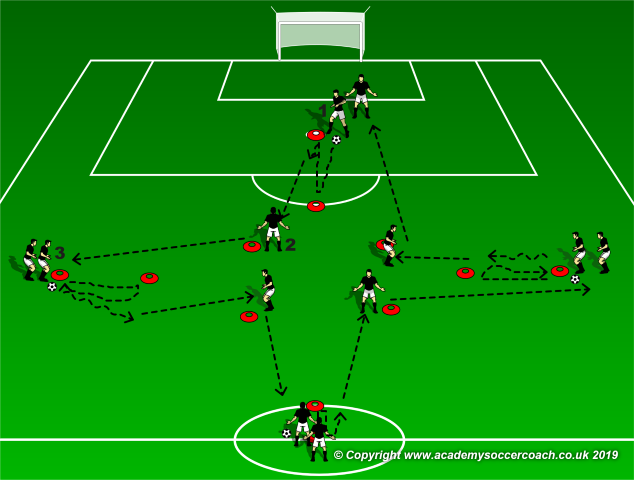
Dribbling Passing and Receiving Drill
By Arthur Bell –
Setup:
Area – Half pitch.
Players x 12 – 20
Markers x 12 red.
Balls x 4
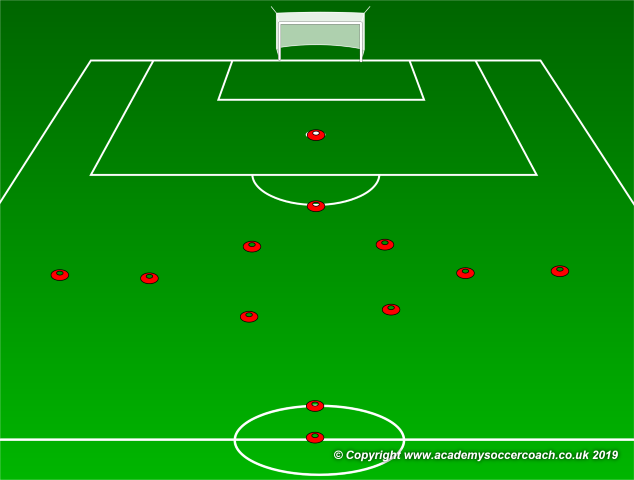
Outside players have a ball each.
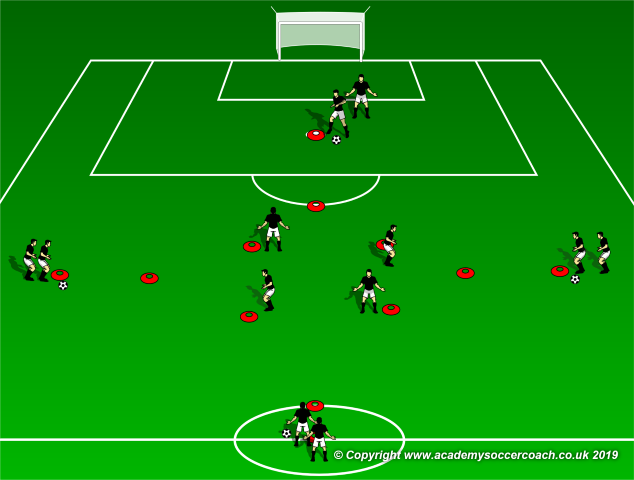
Execution:
Player 1, dribbles towards cone in front, turns and dribble back to initial marker and turns again.
Player then plays a pass to player 2 in the centre.
Player 2 receives and plays ball to player 3.
All outside players start at the same time.

Players follow their pass.
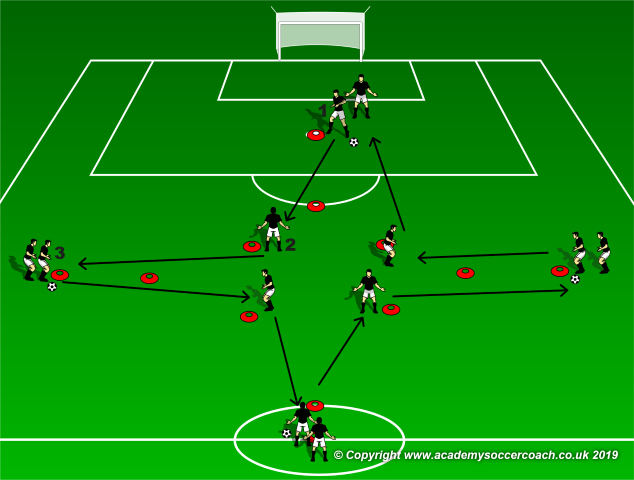
Variations:
1. Change direction of the drill.
2. The player must perform a named 1 v 1 skill e.g. stepover, to make space round the marker before the pass.
3. The player must perform a 1 v 1 skill of their choice to make space round the marker before the pass.
4. For passing and receiving only, remove the inside dribbling markers.
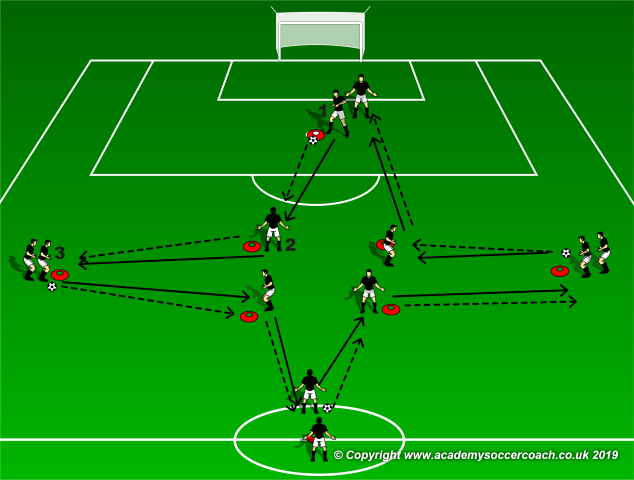
By Arthur Bell
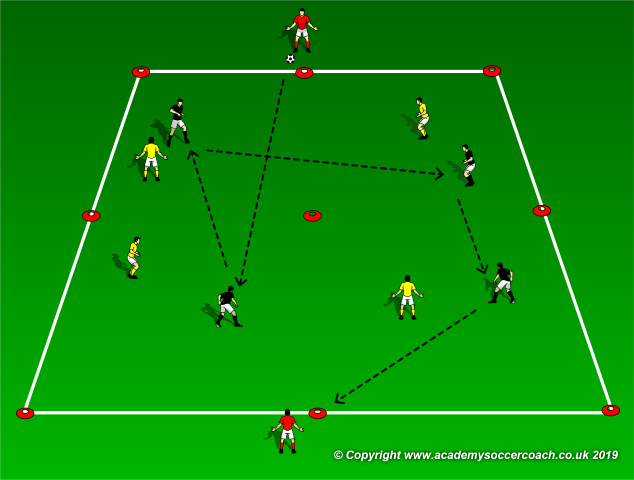
1v1 Small-Sided Game
By Arthur Bell –
Setup:
Area – 20yd x 20yd box.
Players x 4 black, 4 yellow & 2 red
Markers x 9 red.
Balls
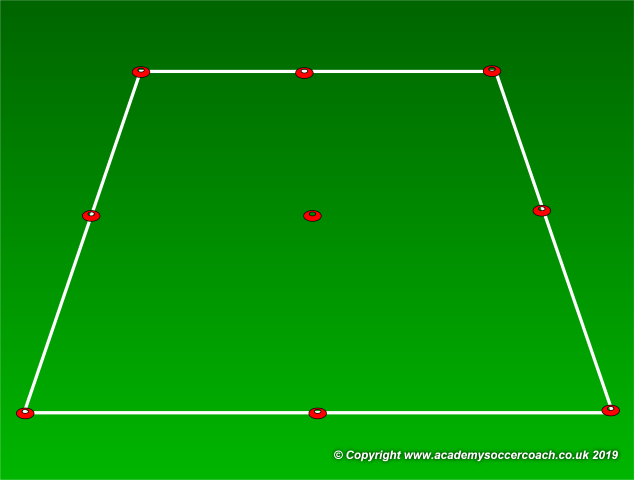
Execution:
All players stay in their zone.
Each team tries to work the ball from one end red player to the other.
Players have unlimited touches.
The same end red player cannot receive the ball twice in succession.
Points are scored by progressing ball from end red player to opposite end red player.
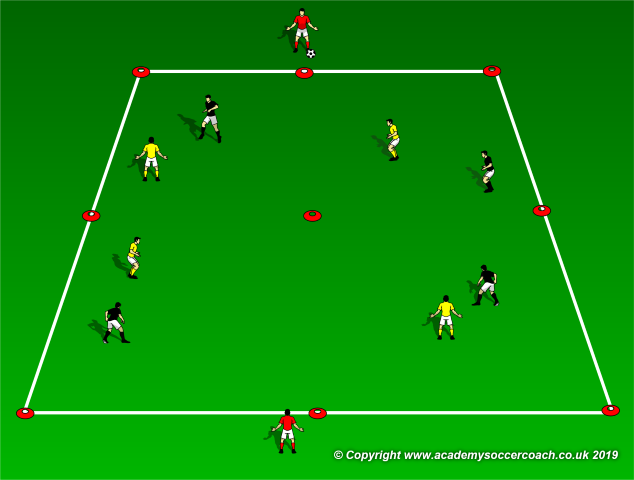
Variations:
1. The ball must go through at least two zones before going to the opposite end red player.
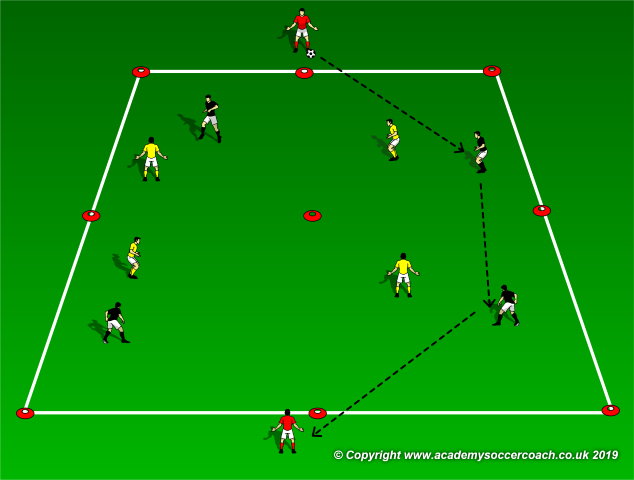
2. The ball must go through all four zones before going to the opposite end red player.

3. Introduce end goals.

By Arthur Bell
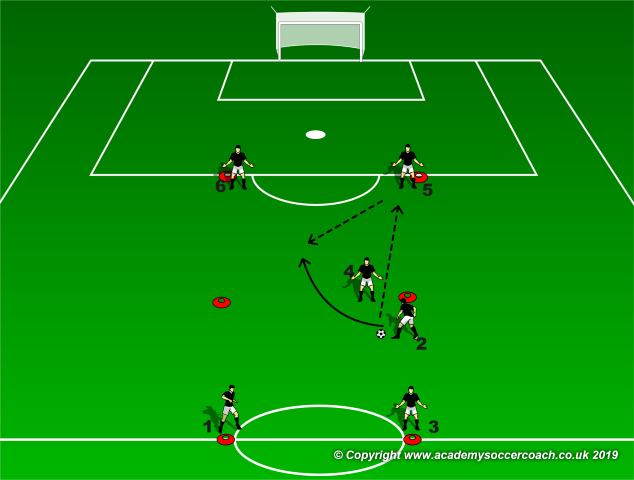
Give and Go Drill
By Arthur Bell –
Setup:
Area – 20yd x 20yd box.
Players x 6
Markers x 6 red.
Balls
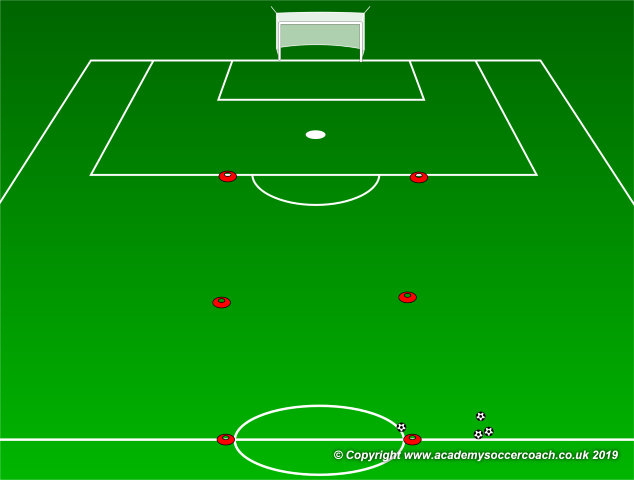
Execution:
Player 1 plays to Player 2 and then closes Player 2.
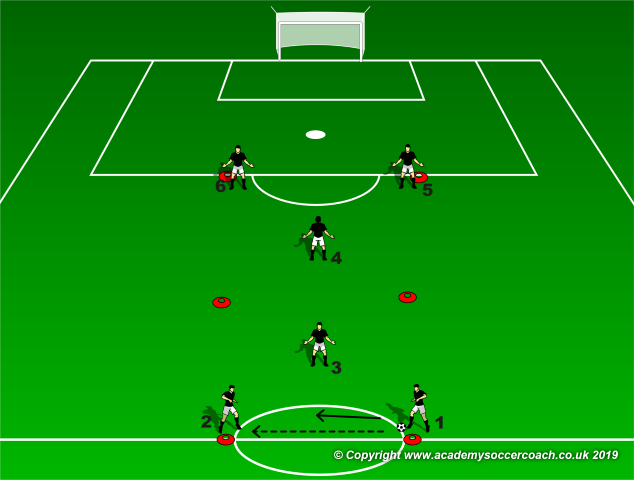
Player 2 plays a “one two” off Player 3 and around Player 1.
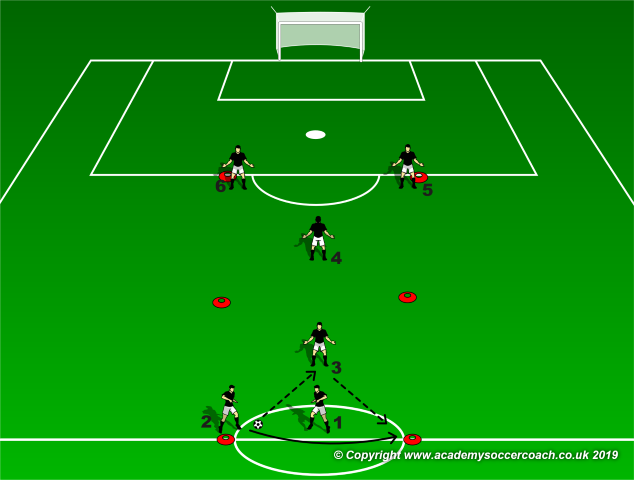
As soon as Player 2 has played the “one-two”, Player 3 closes Player 2.
Player 2 plays a “one-two” off Player 4 and past Player 3.
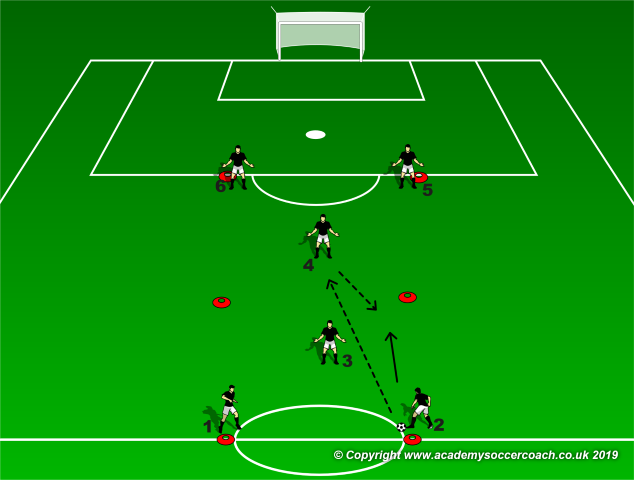
As soon as Player 4 has set ball back to Player 2, Player 4 closes down Player 2.
Player 2 plays a “one-two” off Player 5 and around Player 4.

Player 2 passes to Player 6.
Then the process starts again in the opposite direction.
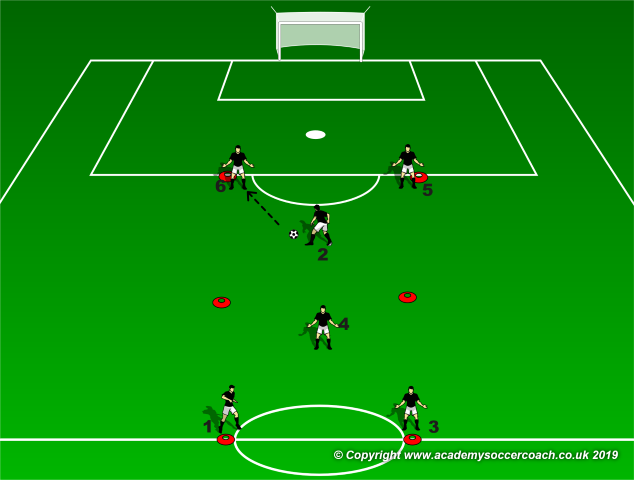
Variations:
1. Players play a maximum of two touch.
2. Players play one touch.
3. How many sequences in a specified time e.g. two minutes?
4. Compete against another group.
By Arthur Bell
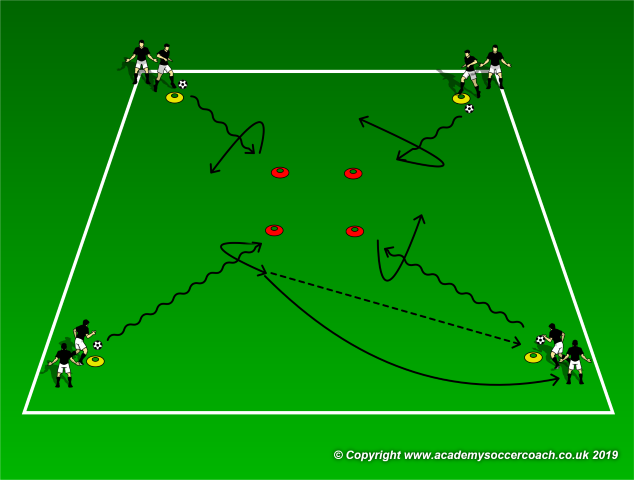
Turning and Dribbling Drill
By Arthur Bell –
Setup:
Area – 20yd x 20yd box.
Players – 8 to 12
Markers x 4 yellow, 4 red.
Balls x 4
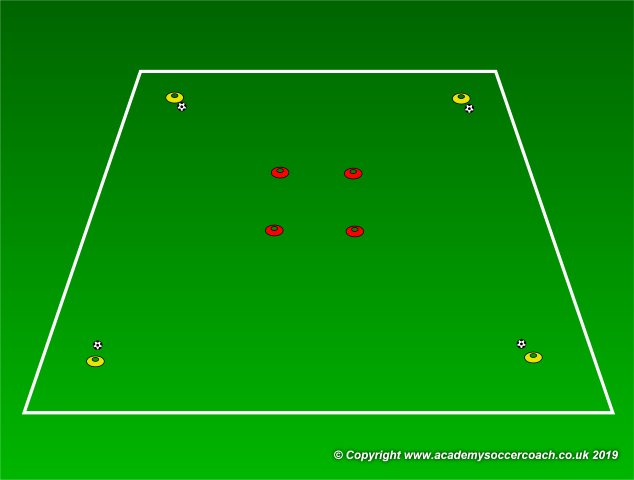
Execution:
Players at all four outside markers start at the same time.
One ball each, players dribble into the inner marker, turn away from cone and pass the ball out to the next cone in an anti-clockwise direction.
The player then follows the pass to the next marker.
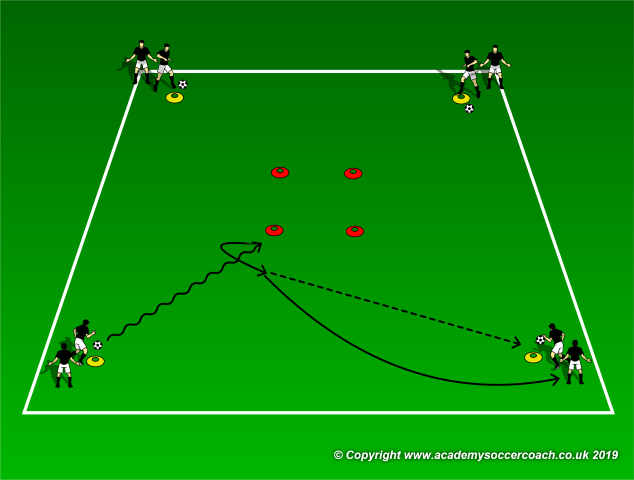

Variations:
1. Players dribble into the inner marker, dribble round the marker then continue to the second marker and dribble round. They then pass the ball out to the next cone in an anti-clockwise direction. Players follow their pass.
2. Players dribble round three markers before passing to the outside marker.
3. Players dribble all four markers before passing to the outside marker.
4. As above in a clockwise direction.
5. Coach nominates specific turns.
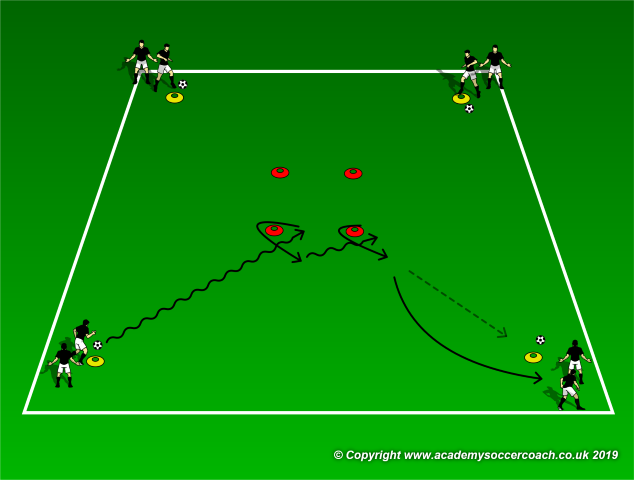
By Arthur Bell
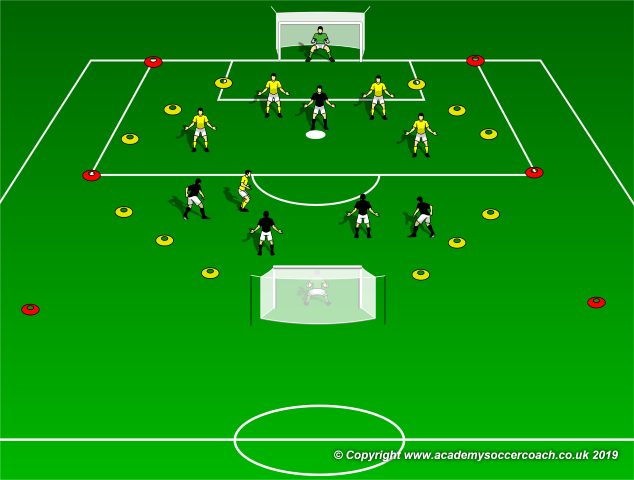
Finishing from Distance Drill
By Arthur Bell –
Setup:
Area – Double penalty box.
Players – 5 black, 5 yellow. 12 (6v6, 4 players and a keeper in the defensive half, 1 player in the attacking half)
GK x 2
Markers x 12 yellow, 6 red.
Goals x 2 full size.
Balls.
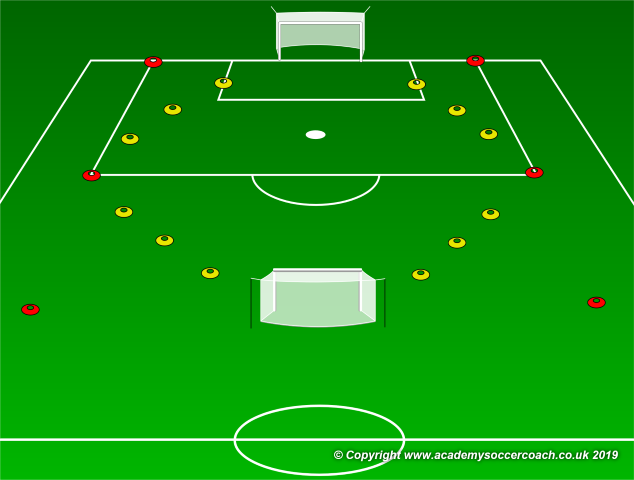

Execution:
Play 6v6 with each team attacking a goal.
Play begins with the GKr who must roll the ball to a player in the same half.
There is only one player forward in the attacking half.
Players cannot cross the halfway line.
Player in the attacking half cannot score.
Players can only score from their own half.
Attacking player looks to intercept or gain rebounds and recycle to their own half.
If ball goes out of play, play restarts from the other GK.
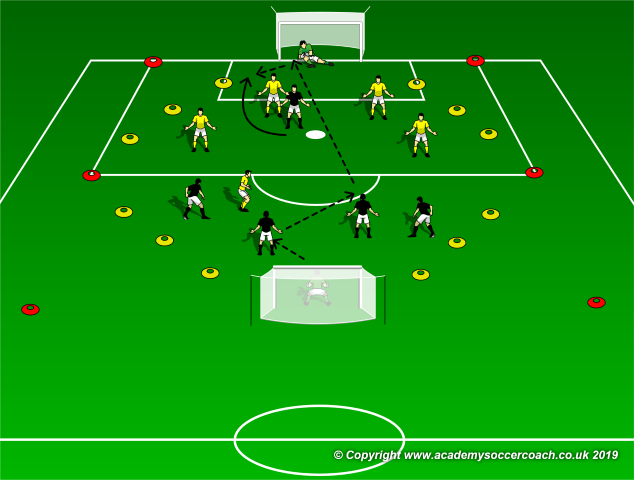
Variations:
1. A second player goes into the attacking half.
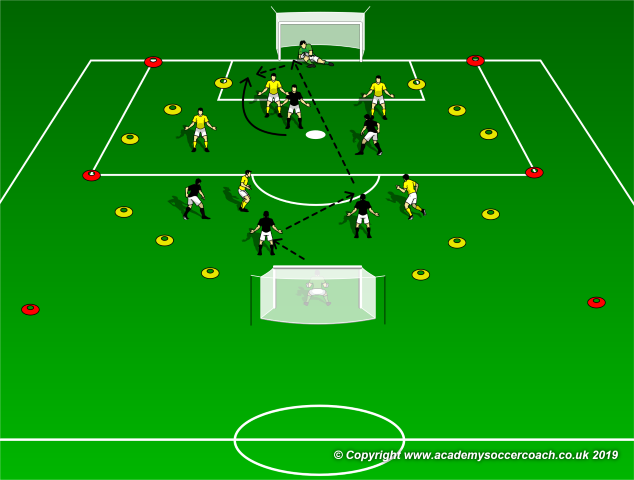
2. Attacking players can score from the attacking half if the last touch was from an opponent, i.e. rebounds, interceptions.
By Arthur Bell
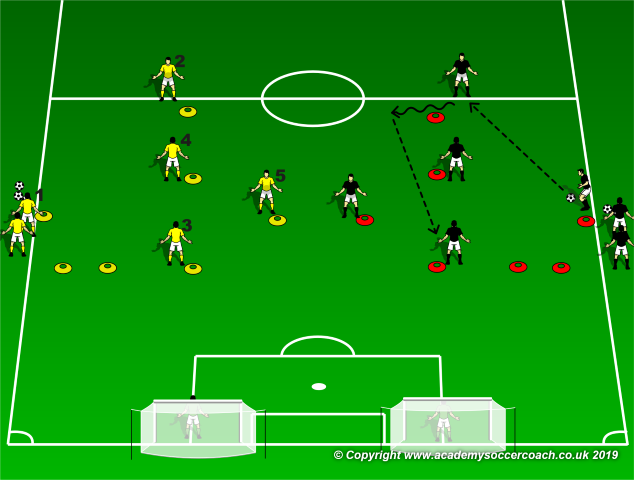
Two Goal Finishing Drill
By Arthur Bell –
Setup:
Area – 1/2 of pitch.
Players – 8 to 10 black, 8 to 10 yellow.
GK x 2
Markers x 7 yellow, 7 red.
Goals x 2 full size.
Balls.
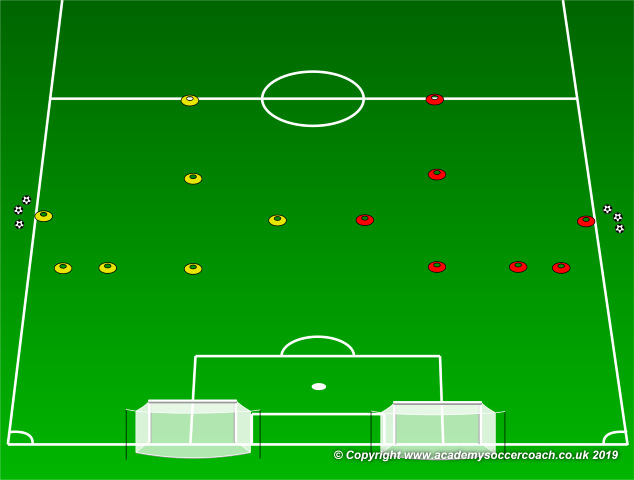
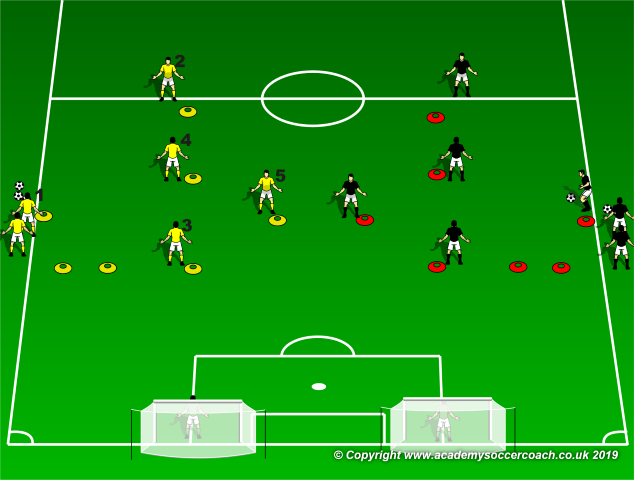
Execution:
Player 1 starts with the ball, passes to Player 2, then follows pass.
Player 2 takes the ball to the side and plays an angled pass to Player 3, then follows pass.

Player 3 takes the ball at an angle to pass back to Player 4, then spins through the gate.
When Player 4 spins to receive the ball.
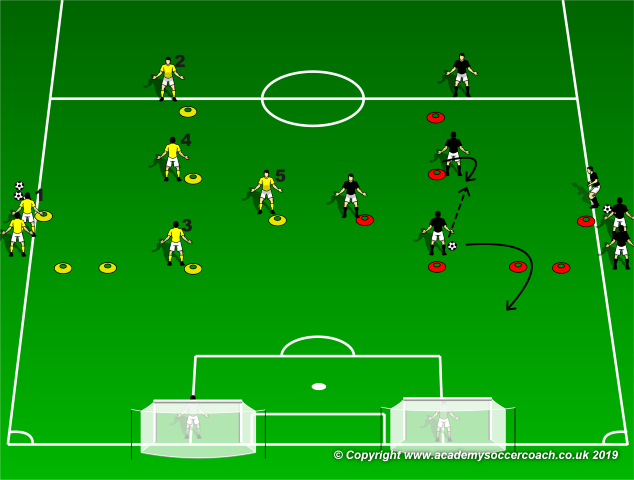
Player 4 receives the ball and plays a through pass to Player 5.
Player 5 receives and shoots.
Player rotation 1 to 2 to 3 to 4 to 5 to Start.
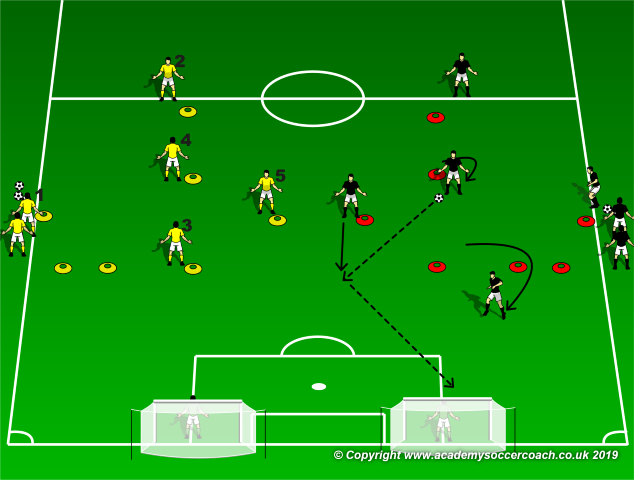
Variations:
1. Players have a maximum of two touches.
2. Player 5 cuts back to the supporting Player 3.
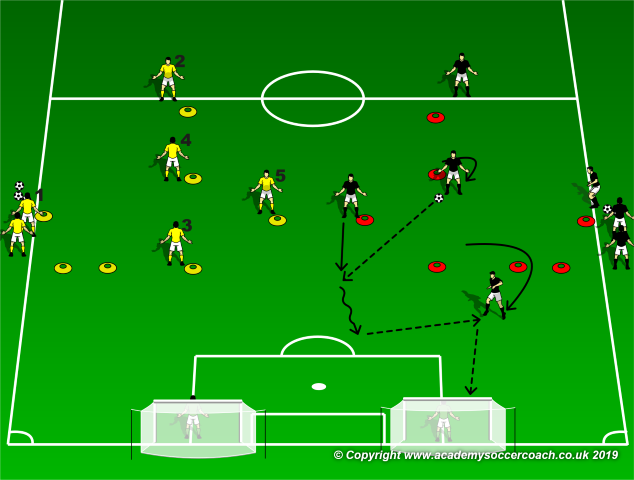
3. Player 5 opts to shoot or cut back to Player 3.
4. Change sides after a certain time.
5. Make it rotational, Player 5 rotation, goes to start of the other side.
By Arthur Bell
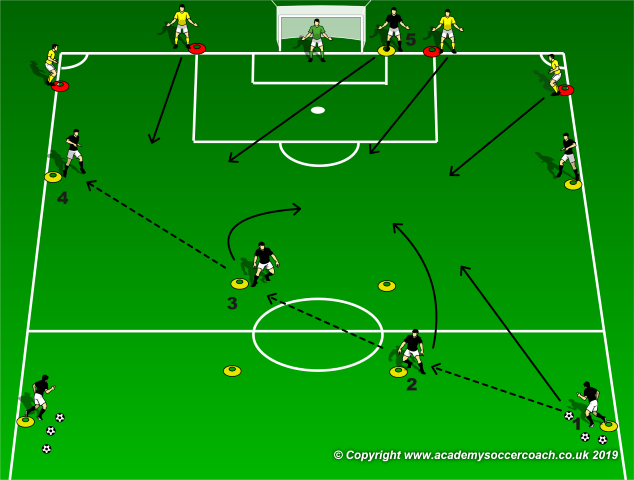
Attack v Defense SSG
By Arthur Bell –
Setup:
Area – 2/3 of pitch.
Players – 8 black, 4 yellow.
GK x 1
Markers – 10 yellow, 4 red.
Balls.
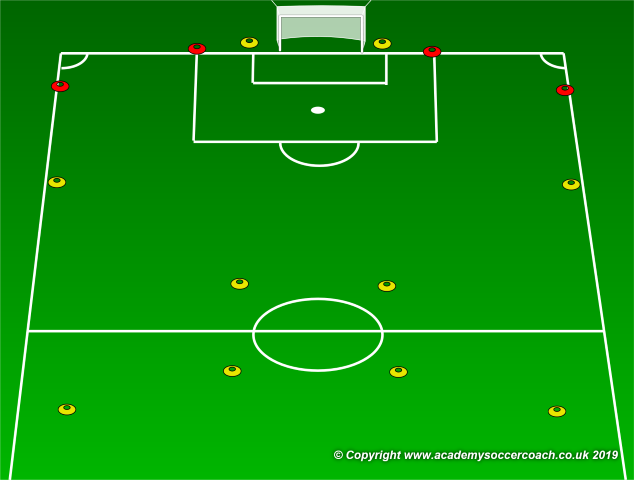
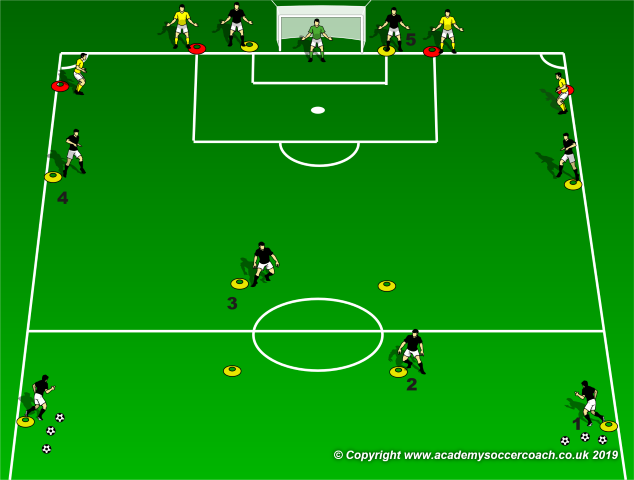
Execution:
Player 1 starts with the ball, passes to Player 2, then supports play.
Player 2 passes the ball to Player 3, then supports play.
Player 3 passes the ball to Player 4, then supports play.
When Player 1 initiates the first pass, Player 5 and two defenders come into the play.
When Player 4 receives the ball, it becomes five attackers versus two defenders.
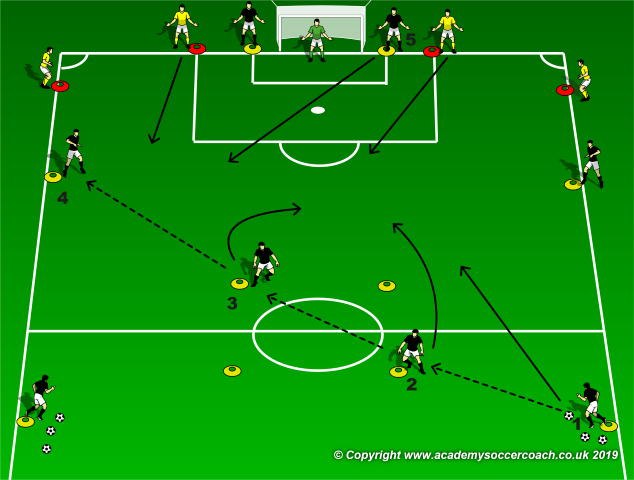
When Player 4 receives the ball, it becomes five attackers versus two defenders.
Play continues until a goal is scored, the Goal Keeper saves, a defender wins possession, or the ball goes out of play.
Players return to their positions, Players 2 and 3 change sides and the attack starts on the other side.
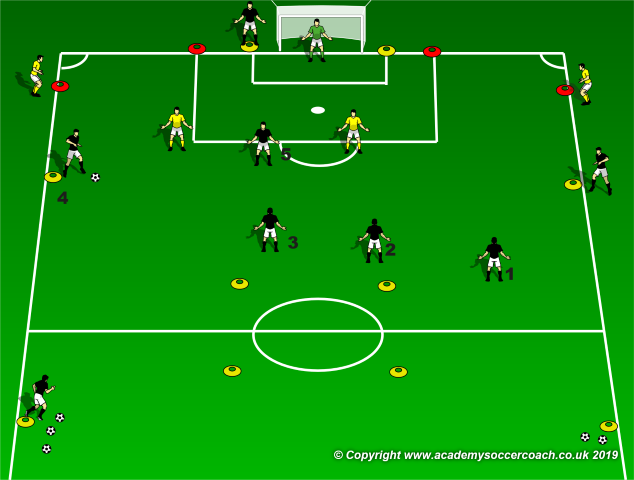
Variations:
1. Players have a maximum of two touches.
2. Five attackers versus three defenders.

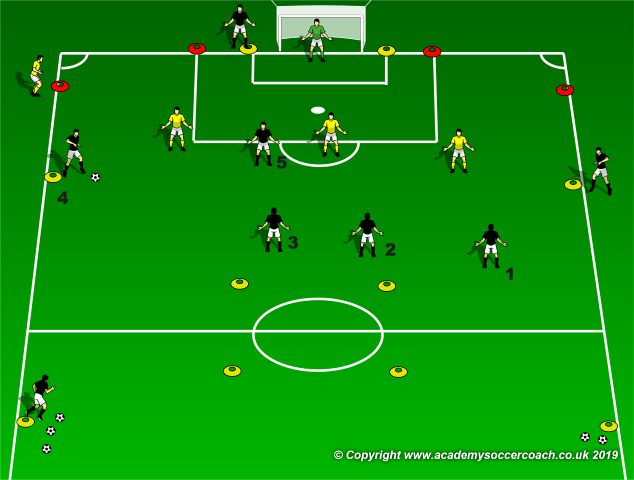
3. Five attackers versus four defenders.
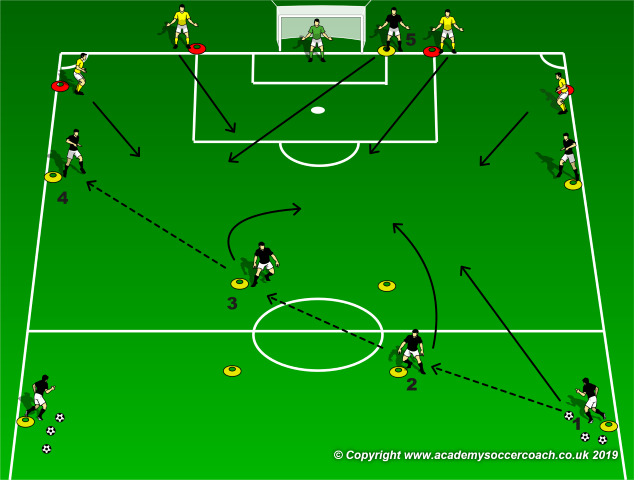
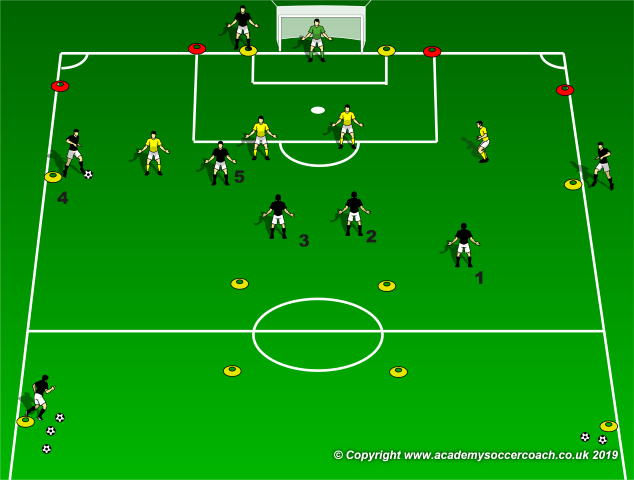
By Arthur Bell
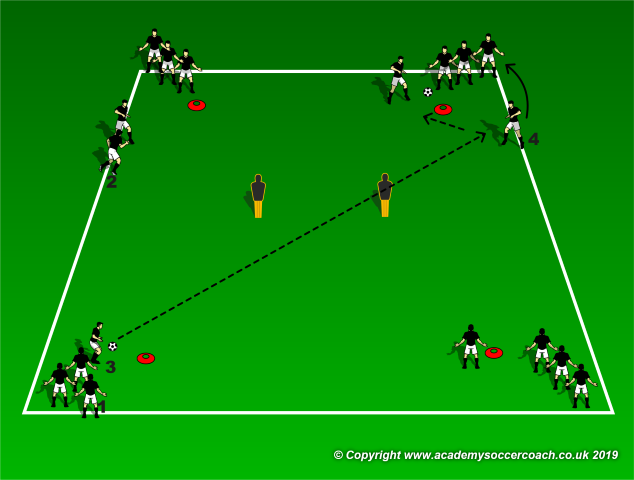
Switching Play Drill
By Arthur Bell –
Setup:
Area – 30yds x 20yds.
Players x 18.
Mannequins x 2.
Markers x 4.
Balls x 2.
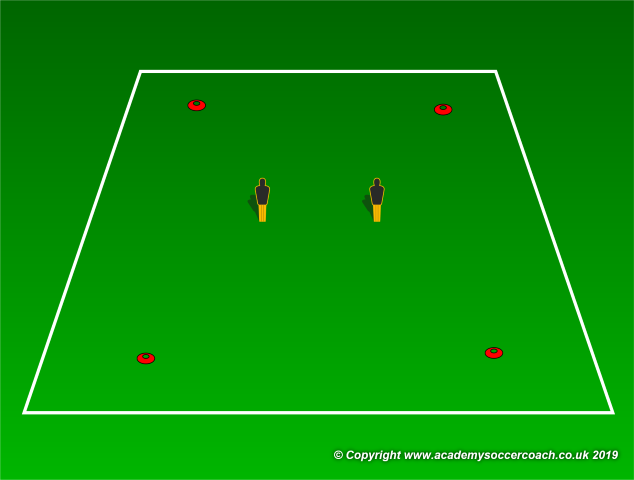
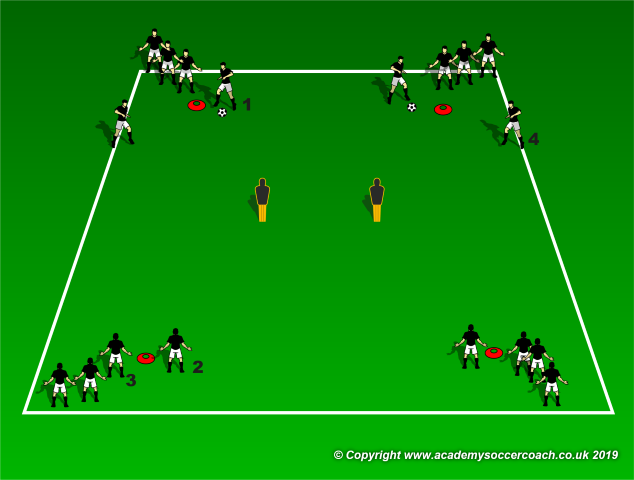
Execution:
Both groups start at the same time, at the same end.
Player 1 passes the ball to Player 2.
Player 1 runs between the mannequins towards player 2.
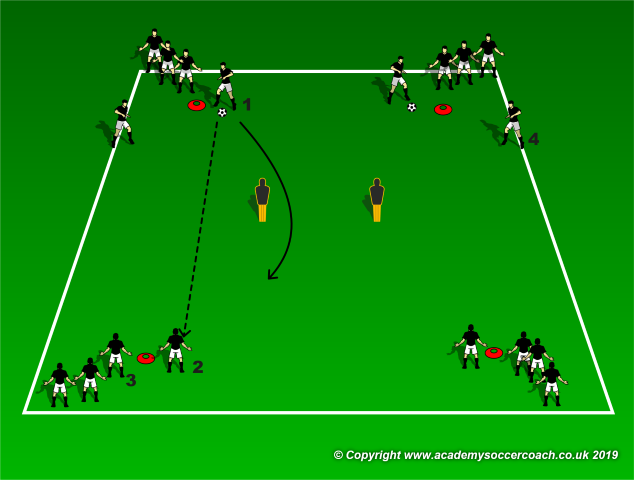
Player 2 lays off the ball to Player 1.
Player 2 runs to the next position.
Player 1 passes to player 3.
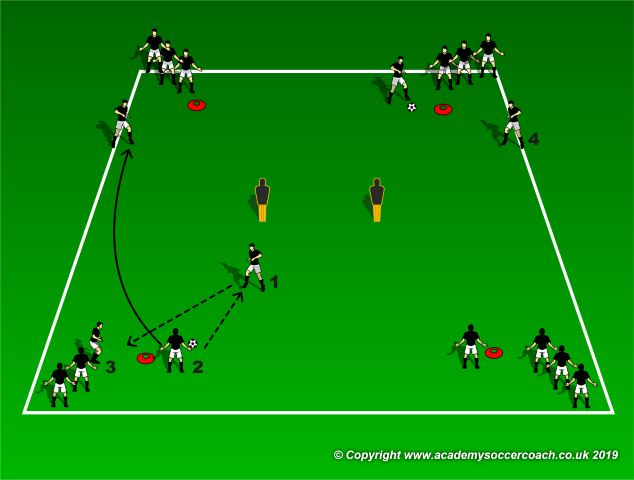
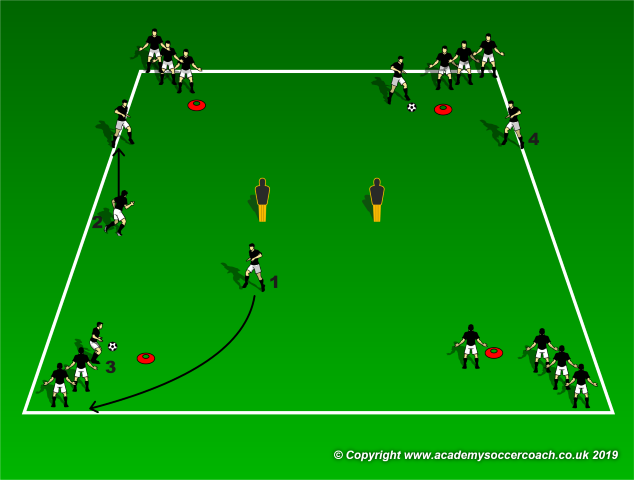
Player 3 receives, and switches play to Player 4.
Player 4 receives, and plays ball back to the start, then joins that group.

Movement pattern of the ball.
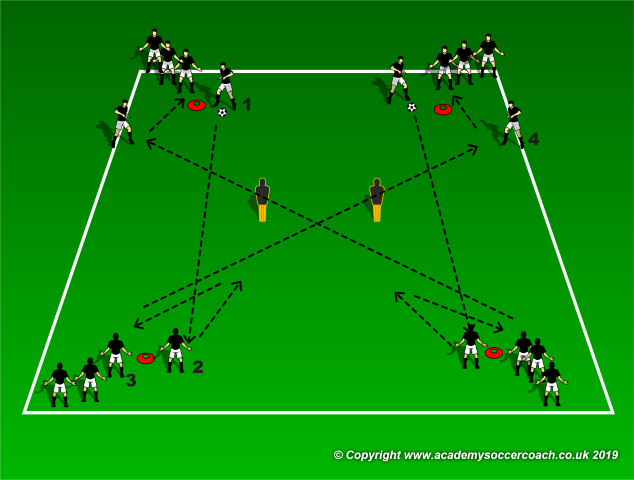
Movement pattern of players and ball.
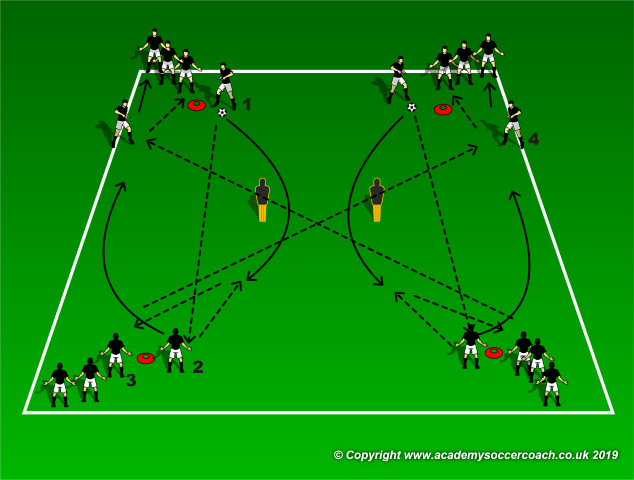
Variations:
1. Players have a maximum of two touches.
2. The diagonal pass is lofted.
3. The diagonal pass is driven.
By Arthur Bell
